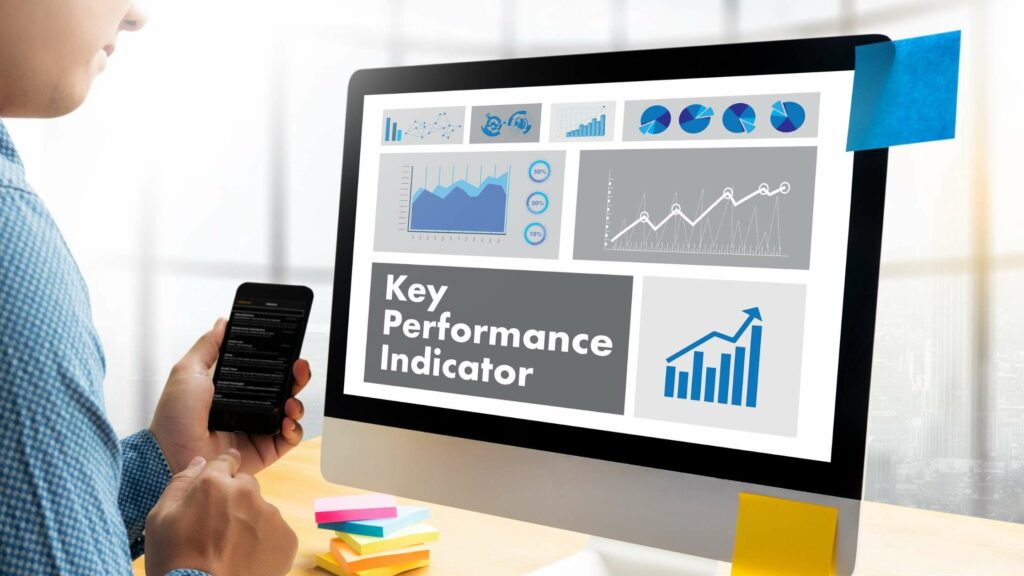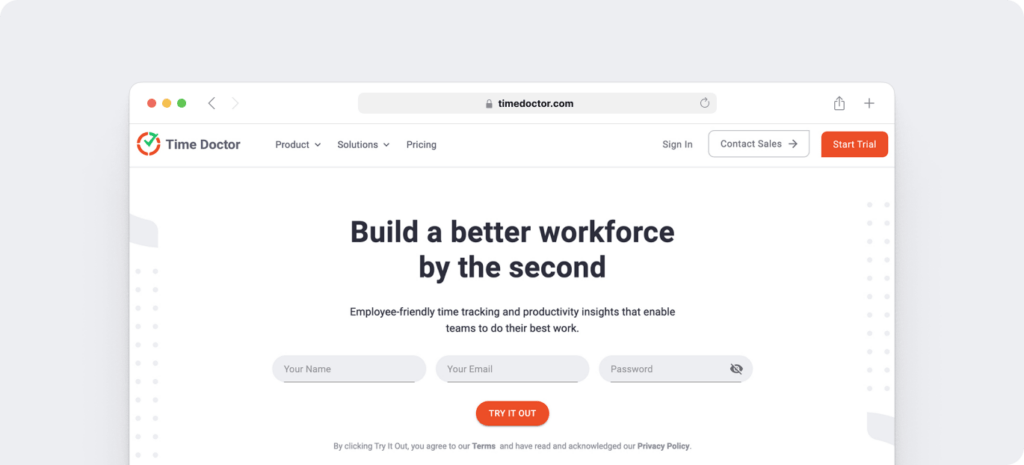Curious about productivity KPIs?
Productivity KPIs (key performance indicators) help measure how effectively your company achieves its core business objectives.
And while the term may seem complex, using KPIs to measure your company’s success is pretty easy!
In this article, we’ll discuss productivity KPIs, why they matter, and how to use them to improve employee performance. We’ll also provide some productivity KPI examples and a free template that you can customize for your needs.
This article contains:
(Click on the links below to go to a specific section)
- What are Productivity KPIs?
- Why are KPIs Important?
- 5 Steps to Creating Useable Productivity KPIs
- A Free KPI Template
- 5 Employee Productivity KPI Examples
- A Smart Way to Measure Productivity In 2021
Let’s get started.
What are productivity KPIs?
A productivity KPI is a measurable metric that indicates how effectively a company is achieving its key business goals and objectives. For example, measuring the overall productivity of your workforce, sales growth, etc.
Organizations use these operational KPIs at various levels to evaluate productivity and determine whether they’ve met their targets.
Now there are two levels of productivity KPIs:
- High-level operational KPIs focus on the overall performance of the entire organization.
- Low-level KPIs focus on processes within individual departments, including sales, HR, product development, etc.
Why are KPIs important?
Unlike a lagging indicator that usually measures past trends and helps evaluate changes over time, KPIs can predict future performance and measure past performance.
Tracking these metrics lets you improve overall results and align your employees and processes with your organizational goals.
Here are a few things you can do with productivity KPIs:
- Calculate the company’s financial performance, which is crucial for a healthy cash flow.
- Get detailed information about productivity from the highest level (your organization) through departments, teams, right down to each employee.
- Identify actionable ways to accomplish overall business strategies and objectives.
- Bring attention to any issue that might otherwise go unnoticed so you can enhance efficiency.
- Determine your sales team’s lead conversion rate, which is the rate at which your team converts leads into sales.
- Evaluate employee satisfaction so you can develop actionable solutions to boost employee morale.
KPIs can be quantitative or qualitative, but ultimately they should help contribute to the company’s growth.
5 steps to creating useable productivity KPIs
If you’re wondering how to create the right KPIs for your business, here’s a step-by-step guide:
Step 1: Establish goals
Before creating a productivity KPI, you need to determine your company goals.
For example, let’s say you have a contact center and want to evaluate your call center agents’ productivity. You can’t start measuring how many calls your agents can handle until you know your call center’s purpose.
So ask yourself: ‘Is your call center meant to generate sales or resolve client queries?’
Understanding your call center’s purpose will allow you to begin measuring call volume and evaluating agents’ performance. The same is true for whichever company goal you’re trying to achieve.
Step 2: Establish critical success factors (CSF)
Next, you’ll need to determine your CSFs (critical success factors) from the goals you’ve established.
These are the key activities that individuals or departments within your organization need to focus on as they’re critical to your company’s success. In other words, they’re specific conditions that help you meet your business objective within a set amount of time.
The best CSFs usually begin with an action verb, for example, attract, expand, increase, etc.
CSFs combine two key elements:
- A measurable activity.
- A set time frame.
For example: Increase sales by 10% over the next four months.
Step 3: Use CSF to establish KPIs
Once you’ve established CSFs, you can use them to set KPIs.
But what’s the difference between a CSF and a KPI?
CSFs are the actions that you need to take for a successful strategy. KPIs are measures that quantify CSFs and enable you to measure performance.
Here’s an example of CSF and KPI:
- Your CSF could be to increase overall customer satisfaction over 12 months.
- Your KPI could be the percentage of satisfied customers.
Step 4: Collect measures
Collect the numbers you need to measure KPIs.
You would usually get these data points from corporate databases, Excel spreadsheets, call center reports, and various other analytical tools.
Some examples of measures include:
A. Employee timesheets
Whether you want to measure remote employee productivity, overtime hours, attendance, estimate employee capacity, etc., you’d need to check employees’ daily timesheets.
B. Customer survey results
If customers rate their interactions with employees, you can use this data for quality assessments of the individual employee and the company as a whole.
C. Sales reports
These reports help you calculate your customer retention rate (i.e., rate of repeat or consistently returning customers.)
Step 5: Use measures to calculate KPI metrics
KPI metrics are the calculations of measures expressed as percentages, averages, rates, or ratios. They’ll need to be defined by a time frame.
Here’s an example:
Calculate the percentage of queries solved by the customer service department this month as compared to last month.
For this, you’ll need to gather all the data relating to the total number of queries submitted by customers monthly, as well as the number of questions answered.
This is how you can find the percentage of queries solved:
- Deduct the total number of queries from the number of closed queries.
- You’ll need to do this for each month and convert the number to a percentage.
- Compare each month’s percentage to determine whether your team’s performance is improving, stagnant, or deteriorating.
You can adapt this method to whatever aspect of the business you’re trying to evaluate.

A free KPI template
You can use this Key Performance Indicator template to develop new KPIs or improve the ones you already have:
1. Indicator name
Name your KPI to make group discussions easier. The name should clearly explain what the indicator is about.
For example, “Net Web Leads Score (NWLS).”
2. Strategic goals
Identify which of the company’s strategic objectives the KPI relates to. This will allow everyone looking at the KPI to recognize its relevance immediately.
For example, “Increase sales.”
3. Audience and access
Define the primary audience for the KPI — the stakeholders who will have access to the KPI.
For example, “The directors and sales team.”
4. Critical success factors (CSF)
Your KPI should detail your CSFs. This will provide context around why you’re creating this KPI. It will also give an idea of the specific issue you’re trying to address.
For example, “Boost product sales over the next 12 months.”
5. How the indicator will be used
Specify how you’ll use the KPI. This will ensure everyone is clear on how you plan to use the data.
Moreover, you’ll need to define how you won’t use the data. For example, we won’t use this indicator to determine individuals’ performance and it won’t lead to any disciplinary action.
This ensures people aren’t afraid to report on measures because they fear the company will use the negative results against them.
For example, “We will use this indicator to assess and report on the volume of website traffic that generates leads. We won’t use this indicator to judge sales performance.”
6. Data collection method
Identify and describe the data collection method. These can include surveys, interviews, questionnaires, focus groups, automated machine data collection, etc.
For example, “The data will be sourced from a combination of automated machine data collection and sales reports.”
7. Data collection frequency
Explain how often the data for the KPI will be collected and make arrangements for collection dates.
For example: “Monthly data collection from a sample of 20% of our customer database.”
8. Targets and performance thresholds
Define a target or benchmark for each indicator.
Here you can also outline the performance thresholds. In other words, when performance levels are good or bad.
For example, “NWLS of 50% by the end of 2022.”
9. Expiry or revision date
The KPI should always include an expiry date or revision date.
KPIs are sometimes only needed for a specific period of time. Without an expiry or review date, these KPIs can continue indefinitely – causing unnecessary work and becoming irrelevant.
For example, “We’ll review this KPI in 12 months.”
10. The value of the KPI
Your KPI should briefly assess how well it’s helping meet the associated CSF (critical success factor) and identify possible limitations.
For example, “The KPI provides a simple number, but you should ideally supplement the data with feedback from website visitors.”
5 employee productivity KPI examples
Don’t want to follow a template to create KPIs?
Here are some customizable productivity KPI examples you can use to evaluate your team:
1. Overall labor productivity
This is a multi-faceted metric that is concerned with shift effectiveness, number of productive hours, etc.
You can calculate the metric by dividing the value of sales by the number of employees.
Companies who calculate overall labor effectiveness can understand what the company has achieved and their workforce efficiency.
2. Top support employees
This KPI helps you recognize your top customer support employees. So, when you know who your best team members are, you can reward them accordingly.
Here are some of the customer service-based indicators you can cross-reference to determine your best support employees:
- First call resolution: The percentage of customer queries an employee can resolve on the first call.
- Average calls per hour: The amount of customer calls a sales rep can handle in an hour.
- Customer satisfaction surveys: Customers will rate employees based on the service they receive.
With these KPIs, you can also identify those employees who are eligible for managerial positions and those who may require more training.
3. Overtime hours
Overtime hours are an excellent way to measure an individual team members’ total cost and output. However, you’ll also have to consider the context for this productivity metric.
For example, let’s suppose a company has an increase in sales. Employees would need to work harder to deliver on their promises and provide the services or products they’re selling.
If overtime hours result from an excessive workload, this may indicate that you need to increase your staffing levels and hire more employees; instead of just reviewing the productivity of the employees you already have.
For a more detailed outcome, evaluate overtime hours in combination with other employee productivity KPIs such as the number of tasks an employee can complete.
This way, you can prevent employee mistakes and high absenteeism that can occur when employees are overworked — both of which affect team productivity.
4. Sales growth
Sales KPIs help you evaluate your team’s performance against your sales, bottom-line, and business goals.
Most businesses have a sales department with sales managers or at least personnel responsible for sales. So most companies would benefit from this sales metric.
To measure sales growth, you’ll need the sales data relating to an employee’s individual performance and team performance.
You’ll need to be flexible, examine what works and what doesn’t, and adjust your KPIs as necessary to improve sales employee productivity.
Keep in mind that sales growth is different from gross profit. To calculate the gross profit, you’d need to consider revenue data as well as production cost, labor cost, etc.
5. Employee turnover rate
This is a useful KPI for your HR department to measure employee retention.
Employee turnover is a part of the business because employees will naturally come and leave depending on their talents and desires.
Managers can use this performance measurement for forecasting when recruitment is necessary. When an employee leaves, they can ensure that there’s no duty left unassigned.
To calculate the employee turnover rate, choose a period, like a month. Then, divide the number of employee departures by the number of active employees during that period.
If the turnover rate is low, your employees are happy and more productive. At the same time, a high turnover reveals that employees are unhappy.
This way, your managers can then identify areas that need attention and find ways to improve employee engagement.
A smart way to measure productivity in 2021
KPIs have become a popular productivity metric.
Unfortunately, it can be challenging to gather data for KPIs – especially if your business offers remote work arrangements.
Don’t worry. There are tools like Time Doctor that can help you out.
Time Doctor helps you track performance metrics and gain insights into the productivity of your in-house and remote employees.
What’s Time Doctor?

Time Doctor is a performance management tool with a user-friendly interface and a range of powerful features. Large corporations and SMEs use Time Doctor to measure and boost their team’s productivity.
Here’s a quick overview of Time Doctor’s robust productivity management features:
- Track time manually or automatically. The data collected can be used for employee performance evaluation or to measure overall labor productivity.
- Detailed real-time analytics in the form of comprehensive reports, including hours tracked, time taken to complete projects and tasks, productive time, etc.
- The productivity ratings feature lets you determine which sites are productive and unproductive (like social media sites). This way, the reports reflect productive time more accurately.
- Powerful integrations with third-party tools. For example, you could track the time a salesperson spends throughout the sales process on Salesforce with the Time Doctor integration. You could also integrate with project management apps like Asana to manage and track workflows.
- The idle time tracker lets you monitor when employees are inactive — the time when no keyboard or mouse movements are detected.
Note: To respect privacy, Time Doctor is not a keylogger. It only tracks whether a key is pressed or not.
Final thoughts
Key Performance Indicators have become a fundamental productivity metric used by companies to determine their success.
Developing the right KPIs and collecting the data needed are the biggest challenges of using this method to evaluate overall productivity.
Now that we’ve provided you with a step-by-step guide to creating your own KPIs and a basic template, evaluating team performance should be a breeze.
To make things even easier, you could use Time Doctor to collect all the employee data to measure actionable productivity KPIs.

Liam Martin is a co-founder of Time Doctor which is software to improve productivity and help keep track and know what your team is working on, even when working from home.


